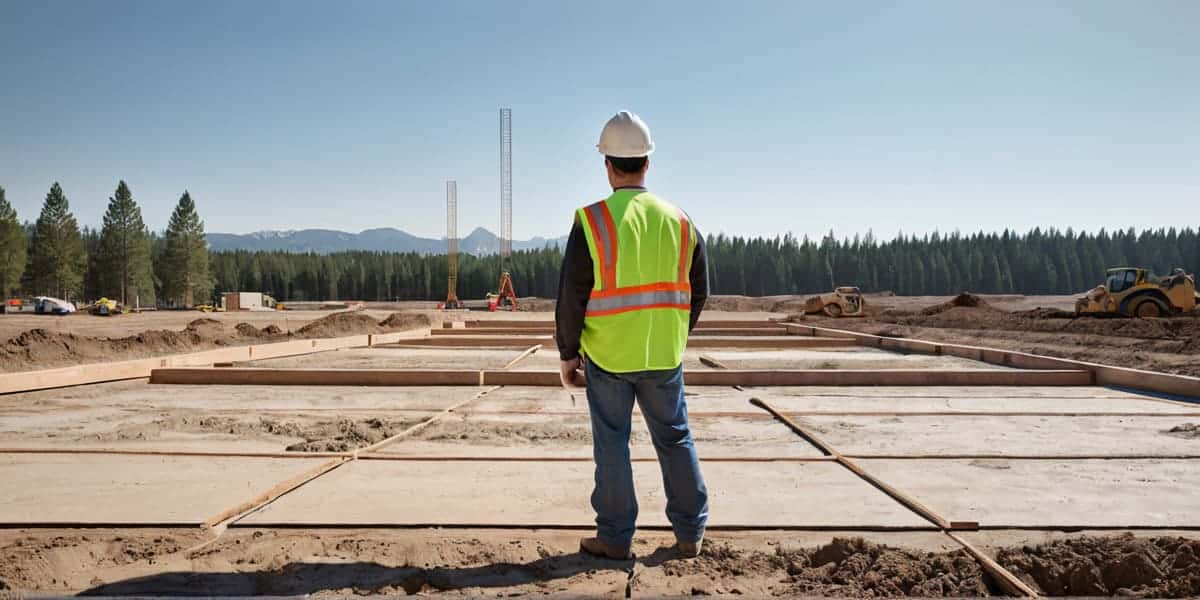 Groundworks Explained – The First Step in Building Success
Groundworks Explained – The First Step in Building Success

Groundworks: The Blueprint of Construction Success?
Groundworks are often likened to the blueprint of construction success, setting the stage for the entire building process. They encompass a range of critical tasks that lay the foundation for all subsequent construction activities. For construction companies, understanding and executing groundworks effectively is paramount to the integrity and longevity of their projects.
Critical Components of Groundworks
Groundworks involve several key components that construction companies must manage meticulously:
- Site-specific assessments: Before any physical work begins, a thorough investigation of the site’s soil, topography, and environmental conditions is essential.
- Execution of tasks: This includes site clearance, excavation, and laying the foundation, which must be carried out with precision and adherence to engineering standards.
- Compliance with regulations: Ensuring that all groundwork activities comply with local building codes and environmental regulations is crucial to avoid legal complications and fines.
Impact on Project Timeline and Budget
The meticulous nature of groundworks can significantly influence the project’s timeline and budget. Delays in groundwork phases due to unforeseen issues like soil instability or water table problems can push back the entire construction schedule. Moreover, the cost of materials and labour for groundworks must be carefully budgeted to prevent financial overruns.
Laying the Groundwork for the Narrative
This section serves as the foundation for understanding the narrative of building success. By comprehensively detailing the importance and intricacies of groundworks, readers gain insight into how these initial steps are critical to the overall construction process. Each component of groundworks is interlinked, and their successful execution is a testament to the skill and foresight of the construction team.

Unearthing the Basics: What Constitutes Groundworks?
Groundworks are the initial phase of construction, essential for setting a solid foundation for any building project. This stage encompasses a variety of activities that prepare the site for subsequent construction work. Understanding these activities is crucial for property developers and construction companies, as they lay the groundwork for the entire project.
Specific Activities in Groundworks
During the groundworks phase, several critical tasks are undertaken:
- Site Clearance: This involves the removal of topsoil and any existing structures or debris from the site.
- Excavation: Creating space for foundations and infrastructure by digging trenches and holes.
- Laying Foundations: Constructing the base upon which the superstructure will stand, tailored to the building’s load requirements.
- Installing Drainage Systems: Ensuring proper water management around and beneath the structure.
Distinction from Other Preliminary Activities
Groundworks are distinct from other preliminary construction activities due to their foundational nature. They are not merely preparatory; they are integral to the structural integrity and longevity of the building.
Importance for Property Developers
For property developers, a thorough understanding of groundworks is indispensable. It informs decisions on resource allocation, project timelines, and budgeting, ultimately impacting the project’s success.
By delving into the specifics of groundworks, this section aims to enhance your foundational knowledge, equipping you with the insights necessary to oversee a successful construction project from the ground up.
Site Analysis and Preparation: The First Strike of the Shovel
Before the physical work of groundworks can begin, a meticulous site analysis is paramount. This initial step is critical as it informs the planning and execution of all subsequent groundwork activities.
The Impact of Site Analysis on Groundworks
A comprehensive site analysis includes:
- Ground Investigation: Assessing soil quality and identifying potential subsurface issues that could affect stability.
- Topographical Survey: Mapping the site’s contours to guide the grading and levelling process.
These assessments are vital as they determine the engineering decisions that will ensure the structural integrity of the project.
Essential Preparation Steps
Key preparation steps include:
- Site Clearance: Removing vegetation, debris, and any existing structures to create a clean slate for construction.
- Levelling and Grading: Ensuring the site is level to provide a stable base for construction activities.
Consequences of Inadequate Preparation
Neglecting thorough site analysis and preparation can lead to:
- Structural Failures: Unforeseen subsurface conditions can cause foundational issues.
- Project Delays: Encountering unexpected problems during construction can significantly delay project timelines.
This section builds on the foundational knowledge of groundworks by emphasising the importance of the initial steps that set the stage for a successful construction project.

Navigating Legal Landscapes: Compliance and Permits
The groundwork phase of construction is not only about physical preparation but also about ensuring legal compliance. Construction companies must navigate a complex legal landscape to secure the necessary permits and adhere to regulations.
Legal Considerations in Groundworks
During groundworks, you must address several legal considerations:
- Zoning Laws: Ensuring the project aligns with local land-use regulations.
- Environmental Regulations: Complying with laws designed to protect natural resources.
- Building Codes: Following standards that dictate safe construction practices.
Obtaining Necessary Permits
To obtain the necessary permits, construction companies typically:
- Submit Detailed Plans: Provide comprehensive project plans to regulatory bodies.
- Undergo Reviews: Participate in inspections and reviews by local authorities.
- Pay Fees: Cover the costs associated with permit applications and inspections.
Risks of Non-Compliance
Non-compliance with groundwork regulations can lead to:
- Legal Penalties: Fines or legal action against the construction company.
- Project Delays: Work stoppages until compliance is achieved.
- Reputational Damage: Loss of trust from clients and partners.
Understanding and adhering to legal requirements is integral to the broader narrative of building success. It ensures that groundworksand the subsequent construction phasesare not only structurally sound but also legally secure, laying a firm foundation for the project’s future.

Digging Deeper: Excavation and Soil Management
Excavation and soil management are pivotal in the groundwork phase, with best practices ensuring the site is prepared for a robust foundation. The strategies employed are influenced by the soil type and conditions, which dictate the specific excavation techniques and soil stabilisation methods required.
Best Practices for Excavation
Key best practices include:
- Assessing Soil Conditions: Conducting soil tests to determine the appropriate excavation depth and equipment.
- Using the Right Equipment: Selecting machinery that matches the soil type to prevent over-excavation and ensure efficiency.
- Monitoring Excavation Sites: Continuously checking for soil stability and potential hazards during the excavation process.
Soil Conditions’ Impact on Groundworks
Soil type can significantly affect groundworks strategies:
- Cohesive Soils: May require different excavation techniques compared to granular soils.
- Water Table: High water tables necessitate dewatering measures to stabilise the excavation site.
Innovative Excavation Techniques
Innovations improving excavation outcomes include:
- GPS and Laser-Guided Machinery: Enhancing precision in excavation.
- Hydro-Excavation: Using high-pressure water to safely break up soil and vacuum it away, minimising disruption to the surrounding area.
These practices and innovations are integral to the groundwork phase, ensuring that the foundation laid is secure and sustainable, thereby reinforcing the central theme of building success from the ground up.
Laying the Foundation: From Stability to Sustainability
The foundation is a critical component of any construction project, serving as the intermediary between the soil and the structure it supports. Groundworks play a pivotal role in ensuring both the stability and sustainability of the building.
Groundworks’ Contribution to Building Stability
Groundworks contribute to building stability by:
- Transferring Loads: Foundations distribute the weight of the structure evenly across the soil.
- Preventing Settlement: Proper groundwork prevents differential settlement that can lead to structural damage.
- Resisting Environmental Forces: Foundations are designed to withstand environmental pressures such as floods and earthquakes.
Sustainable Practices in Foundation Laying
Sustainable practices in laying foundations include:
- Using Recycled Materials: Incorporating recycled concrete and steel reduces the environmental footprint.
- Minimising Soil Disruption: Techniques like screw piling cause less soil disturbance and can be reused or recycled.
- Energy Efficiency: Insulated concrete forms (ICFs) and other materials can improve the energy efficiency of the building.
Impact of Foundation Choices on Long-Term Success
The choice of foundation has a lasting impact on a construction project:
- Durability: A well-designed foundation extends the lifespan of the structure.
- Maintenance Costs: Proper groundworks can reduce the need for costly repairs and maintenance.
This section underscores the importance of groundworks in the narrative of building success, emphasising that the decisions made at this stage have far-reaching implications for the project’s stability and sustainability.

The Backbone of Infrastructure: Utilities and Services Integration
Integrating utilities and services is a critical step in groundworks that requires careful planning and coordination. This integration is essential for ensuring that the future structure is fully functional and meets the needs of its occupants.
Planning and Coordination of Utilities
During groundworks, the integration of utilities involves:
- Mapping Existing Services: Identifying and locating existing utility lines to avoid disruptions.
- Collaborating with Utility Providers: Working closely with service providers to plan the layout of new utilities.
- Incorporating Future Needs: Anticipating the building’s long-term utility requirements in the groundwork design.
Challenges in Utility Coordination
Challenges often encountered include:
- Scheduling Conflicts: Aligning the availability of utility companies with the construction timeline.
- Site Access: Ensuring utility providers have access to the site for installations and connections.
Impact on Timeline and Cost
The integration of services can affect both the timeline and cost of a project:
- Delays: Unforeseen issues with utility integration can cause project delays.
- Budget Adjustments: Changes in utility plans may require budget reevaluation.
This section connects to the ongoing narrative of construction success by highlighting the importance of utilities and services integration in groundworks. Proper planning and execution in this phase are crucial for the seamless progression of the construction project, ultimately contributing to its timely and cost-effective completion.
Overcoming Subterranean Obstacles: Problem-Solving in Groundworks
During groundworks, construction teams often encounter a variety of challenges that can impede progress. Addressing these issues promptly and effectively is crucial to maintaining project timelines and ensuring the success of the build.
Common Groundwork Challenges and Solutions
Challenges during groundworks may include:
- Unexpected Soil Conditions: Encountering soil that is too soft or unstable can necessitate the use of specialised foundation techniques such as piling or ground stabilisation.
- Underground Utilities: Discovering uncharted utility lines requires immediate coordination with service providers to prevent project delays.
- Water Table Issues: High water tables might demand dewatering processes to keep the site dry during construction.
Anticipating and Mitigating Challenges
Property developers and construction companies mitigate groundwork challenges by:
- Conducting Detailed Surveys: Comprehensive pre-construction surveys help anticipate potential issues.
- Developing Contingency Plans: Having backup plans in place ensures quick responses to unforeseen problems.
The Role of Technology in Groundworks
Technology plays a pivotal role in solving groundwork problems through:
- Geotechnical Software: Advanced software models soil behaviour and predicts potential issues.
- Construction Drones: Drones provide real-time aerial views to monitor progress and identify obstacles.
By proactively addressing groundwork challenges, construction companies demonstrate their resilience and adaptability. This problem-solving approach is integral to the narrative of overcoming adversity, ensuring that each project is built on solid ground, both literally and figuratively.

The Cost of the Ground Beneath: Budgeting and Financial Planning
Financial planning is a cornerstone of successful groundworks, as it directly influences the economic viability of a construction project. Groundworks can represent a significant portion of the overall budget, making financial foresight essential.
Strategies for Budgeting Groundworks
To keep groundworks within budget, consider the following strategies:
- Accurate Cost Estimation: Begin with detailed cost estimates that account for labour, materials, equipment, and unexpected expenses.
- Bulk Purchasing: Where possible, buy materials in bulk to benefit from discounts.
- Equipment Leasing: Lease equipment instead of purchasing to reduce upfront costs.
Influence of Financial Planning on Project Success
Effective financial planning during groundworks impacts project success by:
- Preventing Overruns: A well-planned budget helps avoid cost overruns that can derail a project.
- Allocating Resources Wisely: It ensures that funds are available for critical stages of construction.
Adding Depth to Building Success
This section contributes to the narrative of building success by highlighting the importance of strategic financial planning. By managing the groundwork budget effectively, construction companies lay a financial foundation that supports the project’s success, just as the physical groundworks support the structure itself.
Innovations in Groundworks: Embracing Technological Advancements
The field of groundworks is experiencing a significant transformation thanks to technological advancements. These innovations are reshaping traditional methods, making processes more efficient and outcomes more predictable.
Cutting-Edge Technologies Revolutionising Groundworks
Innovative technologies that are making waves in the construction industry include:
- 3D Ground Penetrating Radar (GPR): Allows for precise imaging of what lies beneath the surface, reducing the risk of damaging existing underground utilities.
- Drones: Provide aerial surveys that offer real-time data for better planning and monitoring of groundwork progress.
- Automated and GPS-guided Machinery: Increases precision in excavation and grading, leading to reduced waste and time savings.
Enhancements Brought by Technological Innovations
These technologies enhance groundworks by:
- Improving Safety: Reducing the need for manual surveys in potentially hazardous areas.
- Boosting Efficiency: Streamlining processes and reducing the time required for tasks.
- Increasing Accuracy: Minimising errors in measurements and excavation.
Potential Drawbacks of New Technologies
While promising, these technologies also come with challenges:
- High Initial Investment: The cost of cutting-edge equipment can be prohibitive for some companies.
- Training Requirements: Skilled personnel are required to operate advanced machinery and interpret data.
This section underscores the theme of progress and modernization within the construction industry, illustrating how embracing new technologies in groundworks is pivotal for building success in the contemporary landscape.

Quality and Safety: Ensuring Excellence from the Ground Up
Quality control and safety are non-negotiable aspects of groundworks in construction. They serve as the bedrock of a project’s integrity and the well-being of its workforce.
Essential Quality Control Measures
During groundworks, rigorous quality control is implemented through:
- Material Testing: Ensuring that all materials meet industry standards for durability and safety.
- Regular Inspections: Conducting frequent checks on the work done to catch and rectify any issues early.
- Compliance Audits: Verifying that construction practices adhere to all relevant codes and regulations.
Safety Protocols in Groundworks
Safety protocols are established to protect workers and the project by:
- Personal Protective Equipment (PPE): Mandating the use of helmets, boots, gloves, and other safety gear.
- Safety Training: Providing comprehensive training to all personnel on hazard recognition and prevention.
- Emergency Procedures: Establishing clear protocols for responding to accidents and emergencies.
Consequences of Neglecting Quality and Safety
Neglecting these measures can lead to:
- Structural Failures: Compromising the future integrity of the building.
- Workplace Accidents: Increasing the risk of injuries or fatalities on site.
- Legal and Financial Repercussions: Facing fines, lawsuits, and increased insurance premiums.
This section reinforces the critical role that quality and safety play in the narrative of construction. By prioritising these elements, construction companies ensure that their projects are not only successful but also uphold the highest standards of excellence and care.
Translating Groundwork Principles to Building Success
The principles of groundworks are not just about the initial stages of construction; they are a blueprint for the entire building process. For construction companies and property developers, these principles ensure that every project stands on a foundation of thorough planning, legal compliance, and technical precision.
Key Takeaways for the Construction Industry
As you reflect on the groundworks phase, remember these key points:
- Comprehensive Site Analysis: It is the linchpin for anticipating challenges and planning effectively.
- Adherence to Legal Standards: This safeguards your project against future liabilities and ensures community safety.
- Investment in Quality and Safety: Prioritising these aspects from the outset mitigates risks and enhances project credibility.
Applying Groundwork Lessons to Future Projects
The lessons learned from groundworks can be applied to future projects through:
- Continuous Learning: Embrace new technologies and methods that can streamline groundworks processes.
- Strategic Planning: Use insights from past projects to improve cost estimation and risk management.
- Sustainable Practices: Incorporate eco-friendly techniques that contribute to the longevity and reputation of your builds.
By integrating these principles and lessons, the construction industry can continue to elevate its standards, ensuring that each new project is not only a testament to building success but also a commitment to excellence from the ground up.



